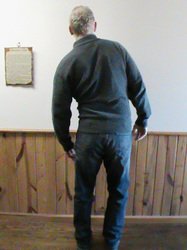Everything You Ever Wanted to Know, but were Too Afraid to Ask
DEFINITION OF "ANTALGIA" or "ANTALGIC": Assuming a specific posture or gait so as to avoid or lessen pain.
One of the three "Cardinal Signs" of disc problems is antalgia. People who have an "antalgic" posture, are contorting their bodies (this happens automatically or unconsciously) to get away from pain. When a person has a Disc Herniation we know that the Nucleus Pulposus (the disc's jelly center) begins to break the innermost layers of the ligamentous Annulus Fibrosus. Although people can have "Posterior Herniations" where the Nucleus ruptures straight backwards into the Spinal Canal / Spinal Cord, Lateral Herniations are far more common.
In the case of a Lateral Disc Herniation, the herniation is slightly offset to either the right or the left. Because the Spinal Nerves exit the Spinal Cord on both the left and the right side, a Lateral Disc Herniation will tend to compress, pinch, or irritate, those nerves. Although this nerve irritation will frequently cause Sciatica or Radiculopathy (pain, numbness, tingling, weakness) that runs into the extremities (arms or legs), there is something that typically happens before this or right along with it. Antalgia.
Because your body does not like pain, it will automatically contort your body into a position where there is less amount of nerve irritation. It is actually common to see very subtle amounts of Antalgia. I frequently have people lift their shirts up so that I can see their belly button. Often times the belly button will be pulled slightly out of center even though the body is not in a grossly antalgic posture.




 RSS Feed
RSS Feed
